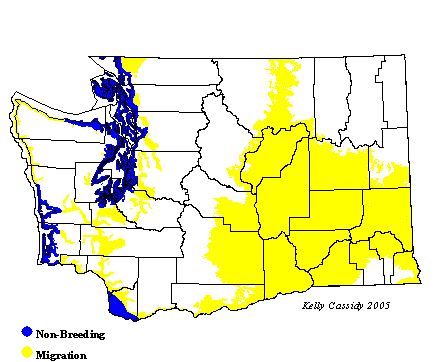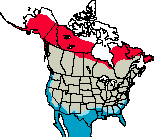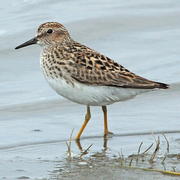Least Sandpiper
General Description
The delicate Least Sandpiper is the world's smallest shorebird. In breeding plumage, it is mostly brown, including the breast. It does not have the streaks and spots on its side that the Western Sandpiper has. The adult in non-breeding plumage is drab gray, with a dark breast. The bill is relatively short and fine-tipped, with a slight droop at the end. Its yellow legs distinguish it from the other two Washington peeps, Western and Semipalmated Sandpipers, which have black legs. In flight, the Least Sandpiper shows a white stripe down its wing and white on either sides of its tail. The underwings are slightly darker than those of the other two peeps, as well. Juveniles are also brownish, but may be brighter rufous than adults, especially in comparison to the faded fall breeding plumage of the adults.
Habitat
Least Sandpipers breed from the northern boreal forest to the sub-Arctic tundra. They typically nest in sedge meadows, muskeg bogs, or coastal wetlands. They migrate all across North America, and some migratory and wintering habitat is coastal, while some is inland. Coastal migrants can often be found along tidal creeks, salt marsh edges, and mudflats, rarely on sandy ocean beaches. Inland migrants inhabit small, shallow ponds, sandy riverbanks, sewage treatment ponds, and lakeshores.
Behavior
Least Sandpipers usually roost by themselves or in small groups. They generally feed at the upper edge of mudflats, often in the vegetation, i.e., higher than Western or Semipalmated Sandpipers. When foraging, they walk slowly with their heads down, picking at food on the surface rather than probing into the mud.
Diet
On the breeding grounds and in inland areas, Least Sandpipers primarily eat fly larvae and other insects. On the coast, they eat small crustaceans, snails, and other marine creatures.
Nesting
Males arrive on the breeding grounds about a week before females and establish territories. Monogamous pairs form quickly after the females arrive. The nest is on the ground near water, and usually on a tuft of grass or moss. The male begins the shallow scrape, and the female finishes it, lining it with grass, leaves, and moss. Both parents help incubate the 4 eggs for about 20 days. As incubation progresses, the male takes a larger and larger share. The young leave the nest within a day of hatching, and feed themselves. The parents will brood and tend the young, and the male generally stays with the brood until they fledge at about three weeks. In later clutches, the female may actually leave before the young hatch, but usually she helps tend the young for the first week or so.
Migration Status
Least Sandpipers migrate across North America and winter from the southern United States into northern South America. Many stage at the Copper River Delta in Alaska in spring, but they remain spread out on the winter range, not concentrating in a few spots as many other shorebirds do.
Conservation Status
The Canadian Wildlife Service estimates the Least Sandpiper population at 600,000 birds. Christmas Bird Count data suggest that wintering Least Sandpipers have declined in Washington. However, many population estimates tend to be insufficient for this species, as it is often lumped with the other small sandpipers and therefore may be undercounted. Also, winter numbers have always been small and are probably not an indicator of the overall health of the population. Least Sandpipers are adaptable and can quickly colonize new breeding habitat. This and their tendency not to congregate in major wintering areas should help the Least Sandpiper in the face of habitat loss, increased disturbance, and contamination.
When and Where to Find in Washington
On the Washington coast, Least Sandpipers can be found most months of the year. Southbound birds begin to arrive in the latter half of June, becoming more common in July. They are usually common until September, when numbers begin to drop off. They winter from Grays Harbor south, and remain uncommon through the winter until April, when spring birds start heading north. During the peak period in late April, concentrations of five to ten thousand have been counted at Grays Harbor. They are usually abundant into mid-May, when numbers start to drop off again, tapering off to rare by the end of May. In eastern Washington, southbound birds arrive in appropriate wetlands at the beginning of July. They are common through mid-September, and some birds are usually present until mid-October. Sightings from mid-October through early April are rare. Spring migrants start passing through in mid-April, and are common from late April through early May, tapering off into early June. They are less common than Westerns in both spring and fall.
 Abundance
Abundance
| Ecoregion | Jan | Feb | Mar | Apr | May | Jun | Jul | Aug | Sep | Oct | Nov | Dec |
|---|---|---|---|---|---|---|---|---|---|---|---|---|
| Oceanic | ||||||||||||
| Pacific Northwest Coast | U | U | U | C | C | C | C | C | F | U | U | |
| Puget Trough | U | U | U | C | C | R | C | C | C | U | U | U |
| North Cascades | U | R | R | U | ||||||||
| West Cascades | U | R | F | F | U | U | ||||||
| East Cascades | U | R | U | F | U | R | ||||||
| Okanogan | U | U | U | F | R | |||||||
| Canadian Rockies | F | F | F | |||||||||
| Blue Mountains | ||||||||||||
| Columbia Plateau | R | F | F | F | C | F | U | R |
Washington Range Map

North American Range Map


Family Members
 Spotted SandpiperActitis macularius
Spotted SandpiperActitis macularius Solitary SandpiperTringa solitaria
Solitary SandpiperTringa solitaria Gray-tailed TattlerTringa brevipes
Gray-tailed TattlerTringa brevipes Wandering TattlerTringa incana
Wandering TattlerTringa incana Greater YellowlegsTringa melanoleuca
Greater YellowlegsTringa melanoleuca WilletTringa semipalmata
WilletTringa semipalmata Lesser YellowlegsTringa flavipes
Lesser YellowlegsTringa flavipes Upland SandpiperBartramia longicauda
Upland SandpiperBartramia longicauda Little CurlewNumenius minutus
Little CurlewNumenius minutus WhimbrelNumenius phaeopus
WhimbrelNumenius phaeopus Bristle-thighed CurlewNumenius tahitiensis
Bristle-thighed CurlewNumenius tahitiensis Long-billed CurlewNumenius americanus
Long-billed CurlewNumenius americanus Hudsonian GodwitLimosa haemastica
Hudsonian GodwitLimosa haemastica Bar-tailed GodwitLimosa lapponica
Bar-tailed GodwitLimosa lapponica Marbled GodwitLimosa fedoa
Marbled GodwitLimosa fedoa Ruddy TurnstoneArenaria interpres
Ruddy TurnstoneArenaria interpres Black TurnstoneArenaria melanocephala
Black TurnstoneArenaria melanocephala SurfbirdAphriza virgata
SurfbirdAphriza virgata Great KnotCalidris tenuirostris
Great KnotCalidris tenuirostris Red KnotCalidris canutus
Red KnotCalidris canutus SanderlingCalidris alba
SanderlingCalidris alba Semipalmated SandpiperCalidris pusilla
Semipalmated SandpiperCalidris pusilla Western SandpiperCalidris mauri
Western SandpiperCalidris mauri Red-necked StintCalidris ruficollis
Red-necked StintCalidris ruficollis Little StintCalidris minuta
Little StintCalidris minuta Temminck's StintCalidris temminckii
Temminck's StintCalidris temminckii Least SandpiperCalidris minutilla
Least SandpiperCalidris minutilla White-rumped SandpiperCalidris fuscicollis
White-rumped SandpiperCalidris fuscicollis Baird's SandpiperCalidris bairdii
Baird's SandpiperCalidris bairdii Pectoral SandpiperCalidris melanotos
Pectoral SandpiperCalidris melanotos Sharp-tailed SandpiperCalidris acuminata
Sharp-tailed SandpiperCalidris acuminata Rock SandpiperCalidris ptilocnemis
Rock SandpiperCalidris ptilocnemis DunlinCalidris alpina
DunlinCalidris alpina Curlew SandpiperCalidris ferruginea
Curlew SandpiperCalidris ferruginea Stilt SandpiperCalidris himantopus
Stilt SandpiperCalidris himantopus Buff-breasted SandpiperTryngites subruficollis
Buff-breasted SandpiperTryngites subruficollis RuffPhilomachus pugnax
RuffPhilomachus pugnax Short-billed DowitcherLimnodromus griseus
Short-billed DowitcherLimnodromus griseus Long-billed DowitcherLimnodromus scolopaceus
Long-billed DowitcherLimnodromus scolopaceus Jack SnipeLymnocryptes minimus
Jack SnipeLymnocryptes minimus Wilson's SnipeGallinago delicata
Wilson's SnipeGallinago delicata Wilson's PhalaropePhalaropus tricolor
Wilson's PhalaropePhalaropus tricolor Red-necked PhalaropePhalaropus lobatus
Red-necked PhalaropePhalaropus lobatus Red PhalaropePhalaropus fulicarius
Red PhalaropePhalaropus fulicarius

